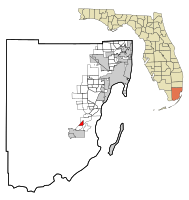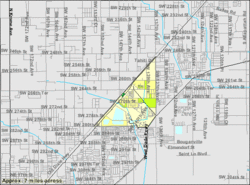Census-designated place in Florida
| Naranja, Florida | |
|---|---|
| Census-designated place | |
 Location in Miami-Dade County and the state of Florida Location in Miami-Dade County and the state of Florida | |
 U.S. Census Bureau map showing CDP boundaries U.S. Census Bureau map showing CDP boundaries | |
| Coordinates: 25°31′N 80°25′W / 25.517°N 80.417°W / 25.517; -80.417 | |
| Country | |
| State | |
| County | |
| Area | |
| • Total | 1.68 sq mi (4.36 km) |
| • Land | 1.50 sq mi (3.88 km) |
| • Water | 0.18 sq mi (0.48 km) |
| Elevation | 7 ft (2 m) |
| Population | |
| • Total | 13,509 |
| • Density | 9,012.01/sq mi (3,480.67/km) |
| Time zone | UTC-5 (Eastern (EST)) |
| • Summer (DST) | UTC-4 (EDT) |
| ZIP codes | 33032, 33092 |
| Area code(s) | 305, 786, 645 |
| FIPS code | 12-47700 |
| GNIS feature ID | 0287532 |
Naranja is an unincorporated community and census-designated place (CDP) in Miami-Dade County, Florida, United States. Many orange groves were once located in this area, so the community name came from the Spanish word for orange, naranja, though the pronunciation among the local residents is "Na-Ran-Jah". Naranja was also a stop for the Florida East Coast Railroad that once ran through this area. It is part of the Miami metropolitan area of South Florida. The population was 13,509 at the 2020 census, up from 8,303 in 2010.
Geography
Naranja is located 25 miles (40 km) southwest of downtown Miami at 25°31′N 80°25′W / 25.517°N 80.417°W / 25.517; -80.417 (25.5174, -80.4217). It is bordered to the north and east by Princeton and to the south by Leisure City, and the city of Homestead is 5 miles (8 km) to the southwest.
U.S. Route 1 (Dixie Highway) runs along the northwest edge of the community. The Homestead Extension of Florida's Turnpike touches the southeast corner of the community, with partial access from Exit 6 (Tallahassee Road) and full access from Exit 5 (Biscayne Drive) in Leisure City.
According to the United States Census Bureau, the Naranja CDP has a total area of 1.7 square miles (4.4 km), of which 1.5 square miles (3.9 km) are land and 0.2 square miles (0.5 km), or 10.99%, are water.
Demographics
| Census | Pop. | Note | %± |
|---|---|---|---|
| 1960 | 2,309 | — | |
| 1990 | 5,790 | — | |
| 2000 | 4,034 | −30.3% | |
| 2010 | 8,303 | 105.8% | |
| 2020 | 13,509 | 62.7% | |
| source: | |||
2020 census
| Race / Ethnicity (NH = Non-Hispanic) | Pop 2010 | Pop 2020 | % 2010 | % 2020 |
|---|---|---|---|---|
| White (NH) | 519 | 696 | 6.25% | 5.15% |
| Black or African American (NH) | 3,172 | 4,150 | 38.20% | 30.72% |
| Native American or Alaska Native (NH) | 11 | 14 | 0.13% | 0.10% |
| Asian (NH) | 193 | 224 | 2.32% | 1.66% |
| Pacific Islander or Native Hawaiian (NH) | 1 | 2 | 0.01% | 0.01% |
| Some other race (NH) | 31 | 89 | 0.37% | 0.66% |
| Mixed race or Multiracial (NH) | 91 | 203 | 1.10% | 1.50% |
| Hispanic or Latino (any race) | 4,285 | 8,131 | 51.61% | 60.19% |
| Total | 8,303 | 13,509 | 100.00% | 100.00% |
As of the 2020 United States census, there were 13,509 people, 3,365 households, and 2,798 families residing in the CDP.
As of the 2010 United States census, there were 8,303 people, 2,081 households, and 1,537 families residing in the CDP.
2000 census
As of the census of 2000, there were 4,034 people, 1,196 households, and 875 families residing in the CDP. The population density was 2,654.6 inhabitants per square mile (1,024.9/km). There were 1,630 housing units at an average density of 1,072.7 per square mile (414.2/km). The racial makeup of the CDP was 32.99% White (12.7% were Non-Hispanic White), 57.54% African American, 0.42% Native American, 1.39% Asian, 0.15% Pacific Islander, 3.89% from other races, and 3.62% from two or more races. Hispanic or Latino of any race were 26.97% of the population.
As of 2000, there were 1,196 households, out of which 48.7% had children under the age of 18 living with them, 30.4% were married couples living together, 36.0% had a female householder with no husband present, and 26.8% were non-families. 20.6% of all households were made up of individuals, and 5.9% had someone living alone who was 65 years of age or older. The average household size was 3.23 and the average family size was 3.73.
In 2000, in the CDP, the population was spread out, with 39.5% under the age of 18, 11.3% from 18 to 24, 27.8% from 25 to 44, 14.0% from 45 to 64, and 7.4% who were 65 years of age or older. The median age was 24 years. For every 100 females, there were 90.6 males. For every 100 females age 18 and over, there were 82.7 males.
In 2000, the median income for a household in the CDP was $18,825, and the median income for a family was $19,443. Males had a median income of $22,614 versus $19,167 for females. The per capita income for the CDP was $7,346. About 42.3% of families and 50.5% of the population were below the poverty line, including 62.7% of those under age 18 and 19.8% of those age 65 or over.
As of 2000, speakers of English as a first language accounted for 66.25% of residents, while Spanish made up 28.14%, French Creole was at 4.64%, and Tagalog was the mother tongue of 0.95% of the population.
Education
Miami-Dade County Public Schools operates area public schools.
Dr. William A. Chapman Elementary School, which opened in 1976, serves the Naranja community, and is located in the CDP. Also serving the Naranja community is Coconut Palm K-8 Academy, which replaced the former Naranja Elementary School. This school is located approximately 3 miles from the former Naranja Elementary School.
Young Men's Academy for Academic and Civic Development (YMAACD) at Miami Douglas MacArthur Senior High School South (MacArthur South), an alternative school, was scheduled to move to the Naranja area for the 2009-2010 school year, in the location of the former Naranja Elementary School. The name has since been changed to Miami Macarthur Educational Center.
Miami MacArthur South Senior High School is also in the CDP. This is a public, alternative school located in Naranja, Florida. It has approximately 107 students in grades 6-12 with a teacher student ratio of 5-1. According to state test scores, at least 10% of the students are proficient in math and 10% in reading.
Notable people
- Jamal Carter (born 1994), American football player
See also
- Naranja-Princeton, Florida, a single census area recorded during the 1980 Census
References
- ^ "2022 U.S. Gazetteer Files: Florida". United States Census Bureau. Retrieved January 11, 2023.
- ^ "P1. Race – Naranja CDP, Florida: 2020 DEC Redistricting Data (PL 94-171)". U.S. Census Bureau. Retrieved January 11, 2023.
- ^ "U.S. Census website". United States Census Bureau. Retrieved January 31, 2008.
- "US Board on Geographic Names". United States Geological Survey. October 25, 2007. Retrieved January 31, 2008.
- Bach, Trevor (March 25, 2015). "In Naranja, Residents Struggle With Violence and Decrepit Buildings". Miami New Times. Retrieved February 4, 2017.
- "Naranja CDP, Florida". United States Census Bureau. Retrieved March 19, 2016.
- "US Gazetteer files: 2010, 2000, and 1990". United States Census Bureau. February 12, 2011. Retrieved April 23, 2011.
- "CENSUS OF POPULATION AND HOUSING (1790-2000)". U.S. Census Bureau. Retrieved July 31, 2010.
- Not enumerated separately in 1970.
- In 1980, Naranja combined with Princeton to form Naranja-Princeton CDP, which enumerated a population of 10,381.
- "P2 HISPANIC OR LATINO, AND NOT HISPANIC OR LATINO BY RACE - 2010: DEC Redistricting Data (PL 94-171) - Naranja CDP, Florida". United States Census Bureau.
- "P2 HISPANIC OR LATINO, AND NOT HISPANIC OR LATINO BY RACE - 2020: DEC Redistricting Data (PL 94-171) - Naranja CDP, Florida". United States Census Bureau.
- "S1101 HOUSEHOLDS AND FAMILIES - 2020: Naranja CDP, Florida". United States Census Bureau.
- "S1101 HOUSEHOLDS AND FAMILIES - 2010: Naranja CDP, Florida". United States Census Bureau.
- "Demographics of Naranja, FL". MuniNetGuide.com. Archived from the original on June 8, 2008. Retrieved November 7, 2007.
- "MLA Data Center Results of Naranja, FL". Epodunk.com. Retrieved November 7, 2007.
- "Executive Summary Dr. William A. Chapman Elementary School Miami-Dade County Public Schools." AdvanceEd. p. 2 (PDF p. 4/7). Retrieved on January 3, 2016. "Dr. William A. Chapman Elementary School is the central focal point of pride within the Naranja community."
- ^ "2010 CENSUS - CENSUS BLOCK MAP: Naranja CDP, FL" (Archive). U.S. Census Bureau. Retrieved on January 3, 2015.
- "About Our School." Dr. William A. Chapman Elementary School. Retrieved on January 3, 2016.
- "FLORIDA DIFFERENTIATED ACCOUNTABILITY PROGRAM 2009 – 2010 SCHOOL IMPROVEMENT PLAN School Name: YOUNG MENS ACADEMY FOR ACADEMIC AND CIVIC DEVELOPMENT AT MIAMI DOUGLAS MACARTHUR SOUTH SENIOR HIGH" (Archive). State of Florida. Last modified September 8, 2009. p. 1. Retrieved on January 3, 2016.
- Home page. Miami MacArthur South Senior High School. Retrieved on January 3, 2016. "Miami Macarthur South: 13990 SW 264 St, Naranja, FL 33032"
| Municipalities and communities of Miami-Dade County, Florida, United States | ||
|---|---|---|
| County seat: Miami | ||
| Cities |  | |
| Towns | ||
| Villages | ||
| CDPs |
| |
| Unincorporated communities | ||
| Ghost town | ||
| Indian reservation | ||
| Footnotes | ‡This populated place also has portions in an adjacent county or counties | |